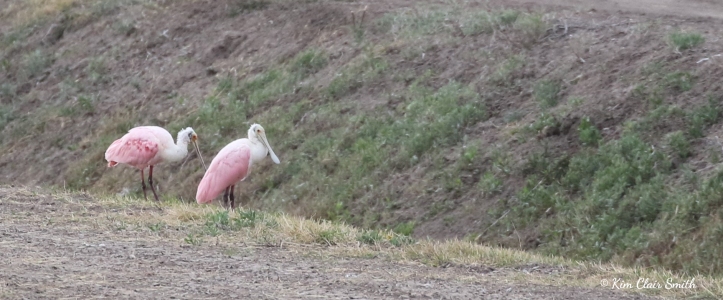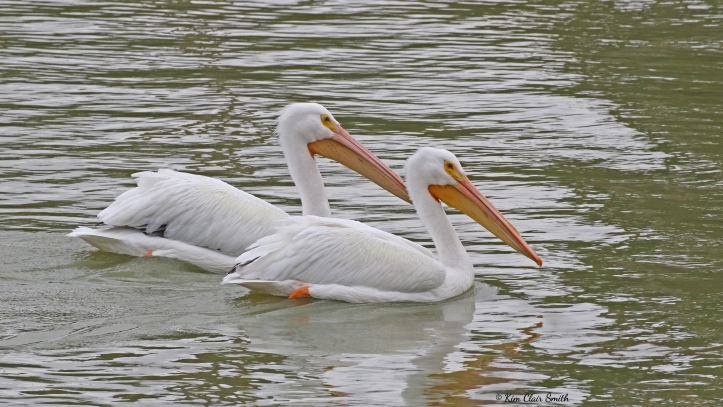Good grief, where do I even begin? I just spent a week down in the Rio Grande Valley of Texas and my head is still spinning from all the beautiful birds I saw. It was so nice to escape the cold of northwest Ohio for a few days, even though the weather down in the McAllen area wasn’t as warm as I’d hoped. Most days we saw high temps in the upper 60s, with quite a bit of cloudiness and some scattered rain.

But that didn’t have much of an impact on how much I enjoyed this trip. My only other visit to this area was in November three years ago, and I didn’t have a very good time on that trip, so I was eager to give Texas a chance to redeem itself. And it did that in spades, with the help of my friend Rick Nirschl.
Rick is a Toledo resident who spends winters in the Rio Grande Valley. He has an amazing ability to find any bird you might want to see, whether it’s in Ohio or Texas. He’s well-known for finding new bird and dragonfly records in both states, and even discovered a dragonfly that had never been identified before (It has since been named the Sarracenia Spiketail, Cordulegaster sarracenia). So with Rick as my world-class tour guide this week, I got to see almost every bird I’d hoped to find, as well as enjoying great conversation and soaking up as much of his knowledge of the natural world as I possibly could. Nature experiences don’t get much better than this.
Places we visited included Quinta Mazatlan, Estero Llano Grande, Santa Ana National Wildlife Refuge, Falcon State Park, and the National Butterfly Center. Rick also knows lots of special spots along various roads and on the private property of his many friends in the area.

One of the things that made a big impression on me down there was that there were birds everywhere, as contrasted with right now in my part of Ohio, which sometimes feels dead and barren because the birds are so scarce.
And in Texas many of the birds are vocal now, whether it’s the noisy chatter of a large flock of blackbirds or parakeets, or the calls of songbirds in the woods. It was just so refreshing to see and hear so much bird activity at a time of year when I’m not able to do that at home. It’s always fun to be down south in winter and see some of “our” birds on their wintering grounds. I saw more Orange-crowned Warblers on this trip than I’ve seen in my entire life!
Each of these photos is more than just a record of the physical presence of a bird. A photo serves as a memory trigger, reminding me of where I was, what I was searching for, who I was with, and even what we were talking about while we watched the birds. When I get to the point in my life where I can’t travel anymore, I’ll be able to re-live these experiences just by looking through my photos.
But I do have a couple stories to tell you about a few photos. Let’s start with one of my favorites, these American White Pelicans. While planning my trip I’d talked to Rick about some birds I’d like to see. But somehow I didn’t even think about pelicans, so of course he didn’t make any special effort to show me those birds. One day he took me to the home of a friend who lives on a resaca, which is a lake formed when an oxbow of the Rio Grande River gets cut off from the main river and becomes a separate body of water.
We got out of the car and started walking toward the back of the house, toward the resaca. Even from a distance I could see the hundreds and hundreds of Black-bellied Whistling ducks out there (I eventually estimated 1,000). That was really neat, because I’d only seen a few of those beautiful ducks in Ohio a few years ago.

But as we got closer to the bank of the lake, I noticed a few pelicans very close to shore, and my jaw dropped as I absorbed their enormity. I quickly stepped behind a large palm tree to try not to spook the birds, and leaned over slightly to start taking photos of them.

Meanwhile, from about 10 feet to my left, Rick was trying to get me to come look at a Ringed Kingfisher. I continued shooting the pelicans and said, “Okay, just a sec, I’m watching the pelicans!” A minute or so later I walked over and looked at the kingfisher, and then went back to watching the pelicans. I just couldn’t get enough of them! In addition to the ones already on the water, I got to see a few more of these colossal birds fly in, a spectacle in itself.
After we were done watching the birds, we got in the car and had a good laugh when Rick said that lots of people come here specifically to find a Ringed Kingfisher, and I was more fascinated with the rather ordinary pelicans. Don’t get me wrong, that kingfisher was pretty neat. But the pelicans were extraordinary. Oh man, I still smile when I think of those enormous birds with buckets on their faces.
Another day we stopped to watch a large flock of Green Parakeets on power lines in the city of Mission. We also saw Monk Parakeets in the town of Hidalgo. As my friend Ryan says, there’s something so cool about green birds. That bright green almost glows on an overcast day, as does the red of a Vermillion Flycatcher, of which we also saw a few.

And speaking of bird colors, I finally got to see a Painted Bunting. This clownish bird is aptly named, because he looks like someone spilled several cans of paint all over him. He makes me smile.

Another excellent experience was finding this Cactus Wren, a life bird for me. (I haven’t tallied up my life birds from this trip, but I probably added twenty species.) Rick walked up to a row of cacti along a fence and said we could probably find a Cactus Wren there, and boom, this one popped up and started singing directly in front of us. We both slow-walked closer and closer, shooting photos as we moved, and we eventually got up to the fence, which put us about 15 feet from the bird. We both got incredible views of this strikingly-marked wren, and he watched us calmly until we started walking away and then he dropped down to the ground and resumed his business.

This Blue Bunting is normally a bird of Mexico and northern Central America, but this species occasionally shows up in southern Texas. This particular bird had been frequenting the feeders at the World Birding Center at Quinta Mazatlan, and after a couple unsuccessful stakeouts, we both got to see it. Unfortunately our sightings were in poor lighting and, combined with the dark color of the bird, made for difficulty getting high quality images. But even a poor image can be a fantastic memory.

One day as we arrived back at my hotel, I saw this White-tailed kite hovering above the adjacent field. This was the first time I’d seen this species in the U.S., and I was excited to try for a photo. I knew the chances of getting a good photo were low because of the white bird against a gray sky, but I took several shots anyway. As I clicked through the series of photos on the computer later, I was struck by the varying wing postures I’d captured as the bird hovered in the air searching for small mammals below. I decided to paste two of the different shots together, and this is the result. Isn’t this bird gorgeous?

One of the birds I’d wanted to see the most was the Burrowing Owl. And, as usual, Rick knew exactly where to find this one.

One bird I hadn’t even considered finding on this trip, however, was a Great Horned Owl. These birds are year-round residents in Ohio, and I was focused mostly on seeing birds I can’t see at home. So imagine my surprise when we arrived at Estero Llano Grande one afternoon and saw this beautiful silvery-gray owl sitting among the wind-tossed fronds of a palm tree.

We don’t have this gray color morph up north, as far as I know, so it was a real treat to see this bird. And we were told that there’s another owl in the park, perhaps the mate of this one, although it’s not a gray morph. Despite the name of the bird, those pointy things on top of the owl’s head are not horns. They’re not ears either. They’re just tufts of feathers. I love how they’re blowing sideways in this shot.
I didn’t take many photos of things other than birds on this trip, but I did grab a quick shot of this cow as it emerged from the vegetation on the Mexico side of the Rio Grande River at Salineño. I noticed that the river had been much lower the last time I’d visited this location, and I wonder if the river ever gets low enough for livestock to cross the international border, and if so, how do they deal with that issue?
Okay, that’s enough for this time. 🙂 Thanks for reading, and stay tuned for more Texas trip stories and photos coming up shortly.



[…] Maybe I should have titled this, “Birder True Confessions,” because I’m going to admit to some embarrassing things that happened on this trip. The first is that I sometimes get excited about birds that other people don’t. I wrote about one such occasion from my trip to Texas last winter, when my friend Rick was trying to show me a ringed kingfisher and I was more excited about a bunch of pelicans. […]
LikeLike
I feel your excitement in seeing and capturing them on camera. How lucky and what a trip!
LikeLike
[…] is a continuation of my previous post about winter birding in Texas. As I try to edit photos to show you, I realize that I saw such an […]
LikeLike
Great birds! I really need to start reading up on birdwatchers’ books. Unfortunately, I do not like bird droppings in my yard very much =)
LikeLiked by 1 person
I recognized a few birds that we see in this area, but mostly, these were not species I was familiar with. You did a great job of documenting your trip. By the way, that is a very poor looking cow. I would be curious what it’s been grazing on. Perhaps, like here, the area is in a drought and there isn’t much to browse on.
LikeLike
Thanks, Lori. And I have a lot more pictures to share in my next post too. As for that cow, I do think I was told that they have been experiencing drought down there, so that might explain the cow’s condition.
LikeLiked by 1 person
Beautiful photos! I love your writing style; I feel like I could have been there with you!
LikeLike
Thank you, Sierra! Glad you enjoyed it.
LikeLike
Great accounting of your trip!
LikeLike
Thanks, Kathy!
LikeLike
I love the painted Bunting because I paint and the thought of splattered paint colors on a bird is great. He is adorable. I also like the comment of the cow crossing from Mexico instead of drug dealers they are all worrying with right now. Just kind of funny! Liked all the pictures Kim!
LikeLiked by 1 person